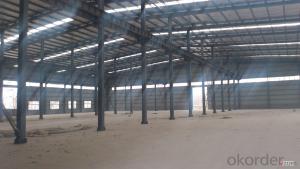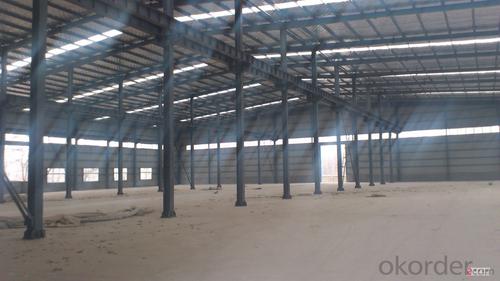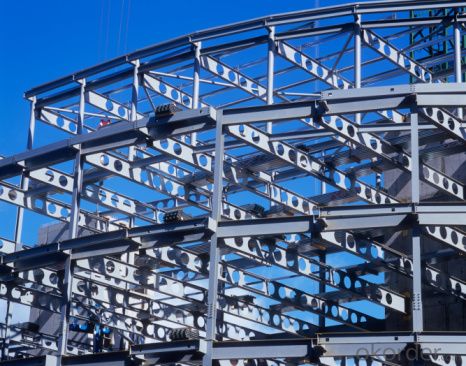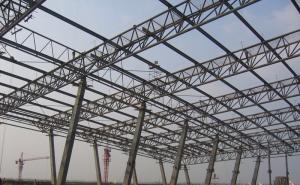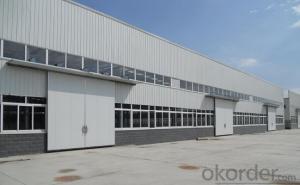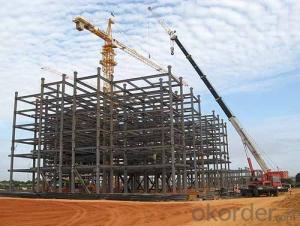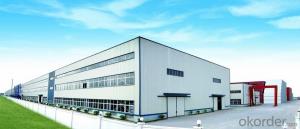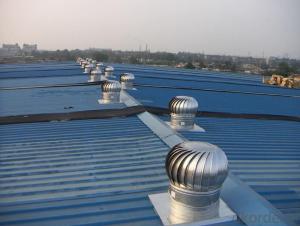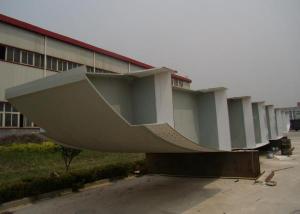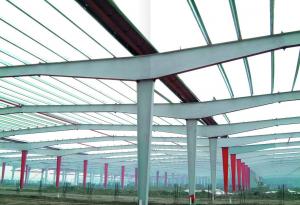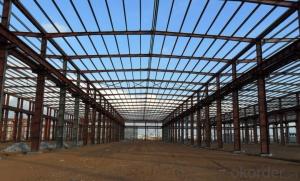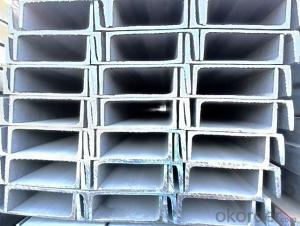Steel Structure Workshop and Steel Structure Warehouse
- Loading Port:
- China Main Port
- Payment Terms:
- TT or LC
- Min Order Qty:
- -
- Supply Capability:
- -
OKorder Service Pledge
OKorder Financial Service
You Might Also Like
Product Description:
OKorder is offering steel structure at great prices with worldwide shipping. Our supplier is a world-class manufacturer of steel, with our products utilized the world over. OKorder annually supplies products to European, North American and Asian markets. We provide quotations within 24 hours of receiving an inquiry and guarantee competitive prices.
Product Applications:
1. Heavy industrial plants: relatively large span and column spacing; with a heavy duty crane or large-tonnage cranes; or plants with 2 to 3 layers cranes; as well as some high-temperature workshop should adopt steel crane beams, steel components, steel roof, steel columns, etc. up to the whole structure
2. Large span structure: the greater the span of the structure, the more significant economic benefits will have by reducing the weight of the structure
3. Towering structures and high-rise buildings: the towering structure, including high-voltage transmission line towers, substation structure, radio and television emission towers and masts, etc. These structures are mainly exposed to the wind load. Besides of its light weight and easy installation, structure steel can bring upon with more economic returns by reducing the wind load through its high-strength and smaller member section.
4. Structure under dynamic loads: As steel with good dynamic performance and toughness, so it can be used directly to crane beam bearing a greater or larger span bridge crane
5. Removable and mobile structures: Structure Steel can also apply to movable Exhibition hall and prefabricated house etc by virtue of its light weight, bolt connection, easy installation and uninstallation. In case of construction machinery, it is a must to use structure steel so as to reduce the structural weight.
6. Containers and pipes: the high-pressure pipe and pipeline, gas tank and boiler are all made of steel for the sake of its high strength and leakproofness
7. Light steel structure: light steel structures and portal frame structure combined with single angle or thin-walled structural steel with the advantages of light weight, build fast and steel saving etc., in recent years has been widely used.
8. Other buildings: Transport Corridor, trestle and various pipeline support frame, as well as blast furnaces and boilers frameworks are usually made of steel structure.
All in all, according to the reality, structure steel is widely used for high, large, heavy and light construction.
Product Advantages:
OKorder's steel structure are durable, strong, and resist corrosion.
Main Product Features:
· Premium quality
· Prompt delivery & seaworthy packing (30 days after receiving deposit)
· Corrosion resistance
· Can be recycled and reused
· Mill test certification
· Professional Service
· Competitive pricing
Product Specifications:
Specifications of steel structure
Project: Jinan west railway station
Position: The Beijing-Shanghai high speed railway (Jinan)
Steel dosage: 5000MTs
Structure type: Box, tube, bending and twisting, transverse connection
1. GB standard material
2. High Structural safety and reliability
3. The production can reach GB/JIS/ISO/ASME standard
Packaging & Delivery of steel structure
1. According to the project design and the component size, usually the main component parts are nude packing and shipped by bulk vessel. And the small parts are packed in box or suitable packages and shipped by containers.
2. This will be communicated and negotiated with buyer according to the design.
Technical support of steel structure
Worker | Rate of frontline workers with certificate on duty reaches 100% |
Welder | 186 welders got AWS & ASME qualification 124 welders got JIS qualification 56 welders got DNV &BV qualification |
Technical inspector | 40 inspectors with UT 2 certificate 10 inspectors with RT 2 certificate 12 inspectors with MT 2 certificate 3 inspectors with UT3 certificate |
Engineer | 21 engineers with senior title 49 engineers with medium title 70 engineers with primary title. 61 First-Class Construction Engineers 182 Second-Class Construction Engineers |
International certification | 10 engineers with International Welding engineer, 8 engineers with CWI. |
Production Flow of steel structure/steel frame
Material preparation—cutting—fitting up—welding—component correction—rust removal—paint coating—packing—to storage and transportation (each process has the relevant inspection)
FAQ:
Q1: Why buy Materials & Equipment from OKorder.com?
A1: All products offered byOKorder.com are carefully selected from China's most reliable manufacturing enterprises. Through its ISO certifications, OKorder.com adheres to the highest standards and a commitment to supply chain safety and customer satisfaction.
Q2: How do we guarantee the quality of our products?
A2: We have established an advanced quality management system which conducts strict quality tests at every step, from raw materials to the final product. At the same time, we provide extensive follow-up service assurances as required.
Q3: How soon can we receive the product after purchase?
A3: Within three days of placing an order, we will begin production. The specific shipping date is dependent upon international and government factors, but is typically 7 to 10 workdays.
Q4: What makes stainless steel stainless?
A4: Stainless steel must contain at least 10.5 % chromium. It is this element that reacts with the oxygen in the air to form a complex chrome-oxide surface layer that is invisible but strong enough to prevent further oxygen from "staining" (rusting) the surface. Higher levels of chromium and the addition of other alloying elements such as nickel and molybdenum enhance this surface layer and improve the corrosion resistance of the stainless material.
Q5: Can stainless steel rust?
A5: Stainless does not "rust" as you think of regular steel rusting with a red oxide on the surface that flakes off. If you see red rust it is probably due to some iron particles that have contaminated the surface of the stainless steel and it is these iron particles that are rusting. Look at the source of the rusting and see if you can remove it from the surface.
Images:


- Q: In the steel structure safety margin refers to what?
- When the calculations of structural steel to the strength and size of your theory, you have to leave, to increase the size or structure of steel used high performance steel, this is the safety margin, or accident probability, general safety margin will add a lot of, or even several times.
- Q: How are steel structures used in the construction of airports?
- Steel structures are commonly used in the construction of airports due to their strength, durability, and versatility. They are utilized for various purposes such as constructing the airport terminal buildings, hangars, control towers, and other facilities. Steel's high load-bearing capacity allows for the construction of large, open spaces, which are essential for accommodating the aircraft and providing ample space for passenger flow. Additionally, steel structures can be prefabricated off-site, allowing for faster construction and minimizing disruptions to airport operations. Overall, steel structures play a crucial role in ensuring the safety, efficiency, and functionality of airports.
- Q: What are the considerations for designing steel structures in areas with high wind loads?
- When designing steel structures in areas with high wind loads, several considerations need to be taken into account. Firstly, the design should meet the local building codes and standards specific to wind loads. The structure should be designed to withstand the maximum wind speeds expected in the area, taking into consideration factors such as the topography and surrounding buildings. Secondly, the shape and profile of the structure should be carefully considered. Aerodynamic shapes, such as streamlined or tapered designs, can help reduce wind resistance and minimize the impact of wind loads on the structure. Additionally, the orientation of the structure and its openings, such as doors and windows, should be strategically planned to minimize the effects of wind pressure. Another important consideration is the selection of appropriate materials and connections. High-strength steel should be used to ensure the structural integrity and resistance against wind-induced forces. Connections between steel members should be designed for maximum strength and rigidity to withstand wind loads. Additionally, the use of bracing systems, such as diagonal or cross-bracing, can enhance the overall stability and reduce the vulnerability of the structure to wind loads. Lastly, regular maintenance and inspection of the steel structure are crucial to ensure its continued performance and safety in high wind load areas. Periodic checks should be carried out to identify any signs of structural damage or degradation, allowing timely repairs or reinforcements to be implemented if necessary.
- Q: What are the considerations when designing steel structures for residential developments?
- When designing steel structures for residential developments, there are several important considerations that need to be taken into account. These include the structural integrity and stability of the steel framework, as well as its ability to withstand various loads and forces such as wind, snow, and seismic activity. It is also essential to consider the aesthetic aspects of the design, ensuring that the steel structure complements the overall architectural style and vision of the residential development. Additionally, factors like cost-effectiveness, sustainability, and ease of construction should be considered during the design process. Ultimately, the goal is to create safe, durable, and visually appealing steel structures that meet the specific needs and requirements of the residential development.
- Q: What are the design considerations for steel canopies?
- Some of the key design considerations for steel canopies include determining the appropriate size and shape of the canopy to meet functional requirements, ensuring structural stability and load-bearing capacity, selecting suitable materials and finishes to withstand environmental conditions, integrating necessary drainage systems, considering aesthetic elements to complement the overall design, and adhering to safety regulations and building codes.
- Q: Can steel structures be designed to be resistant to electromagnetic interference?
- Steel structures have the potential to resist electromagnetic interference (EMI). EMI, which is caused by electromagnetic radiation, can adversely affect the performance of electronic devices or systems. Steel, being an efficient conductor of electricity, can indeed attract and amplify electromagnetic waves. However, there are various approaches that can be employed to mitigate or eliminate the impact of EMI on steel structures. One strategy involves utilizing steel alloys with high magnetic permeability, such as mu-metal or permalloy. These alloys possess the capability to redirect and absorb electromagnetic waves, thus minimizing their influence on sensitive electronic equipment. Additionally, steel structures can be designed with appropriate grounding and shielding techniques to prevent the infiltration of electromagnetic waves. Another method entails implementing electromagnetic shielding materials, such as conductive coatings or screens, on the steel structure. These materials create a barrier that obstructs or reflects electromagnetic waves, preventing their entry into or exit from the structure. Furthermore, the arrangement and placement of electrical wiring and equipment within the steel structure can also have a significant impact on reducing EMI. By properly segregating and isolating sensitive electronic components from potential sources of electromagnetic radiation, the likelihood of interference can be minimized. In conclusion, although steel structures have inherent conductivity that can attract electromagnetic waves, it is possible to design and implement them in a manner that mitigates or eliminates the effects of electromagnetic interference. By employing suitable steel alloys, electromagnetic shielding materials, grounding techniques, and thoughtful layout planning, it is feasible to create steel structures that exhibit high resistance to EMI and provide an appropriate environment for sensitive electronic systems.
- Q: What are the advantages of using steel as a construction material for building structures?
- There are several advantages of using steel as a construction material for building structures. Firstly, steel is exceptionally strong and durable, offering a high level of structural stability and resistance to external forces like wind and earthquakes. Secondly, steel is a versatile material that can be easily manipulated and fabricated into various shapes and sizes, allowing for flexibility in design. Additionally, steel is a sustainable and recyclable material, making it an environmentally friendly choice for construction. Furthermore, steel structures require minimal maintenance and have a longer lifespan compared to other materials, reducing long-term costs. Lastly, steel construction is quick and efficient, as pre-fabricated steel components can be easily assembled on-site, leading to shorter construction periods and faster project completion.
- Q: Can steel structures be designed with natural lighting features?
- Yes, steel structures can indeed be designed with natural lighting features. Steel buildings can incorporate various design elements such as large windows, skylights, or translucent panels to allow natural light to penetrate the interior spaces. These features not only enhance the aesthetics of the structure but also promote energy efficiency by reducing the need for artificial lighting during daylight hours.
- Q: What are the common design considerations for steel structures in theaters and auditoriums?
- Some common design considerations for steel structures in theaters and auditoriums include ensuring adequate load-bearing capacity to support heavy equipment and rigging systems, providing sufficient acoustical insulation to minimize sound transmission, incorporating flexible design elements to accommodate future changes or additions, implementing fire-resistant measures to meet safety regulations, and integrating aesthetic features to enhance the overall visual appeal of the space.
- Q: How are steel structures designed for shopping malls and entertainment complexes?
- Steel structures for shopping malls and entertainment complexes are designed by considering various factors such as the load requirements, architectural design, and safety regulations. The design process involves determining the structural system, selecting appropriate steel sections, and analyzing the structure to ensure its stability and durability. The design also considers factors like the need for open spaces, large span capabilities, and flexibility for future modifications. Advanced computer-aided design tools and techniques are employed to optimize the structural design and ensure the overall efficiency and functionality of the steel structures.
Send your message to us
Steel Structure Workshop and Steel Structure Warehouse
- Loading Port:
- China Main Port
- Payment Terms:
- TT or LC
- Min Order Qty:
- -
- Supply Capability:
- -
OKorder Service Pledge
OKorder Financial Service
Similar products
Hot products
Hot Searches
Related keywords
